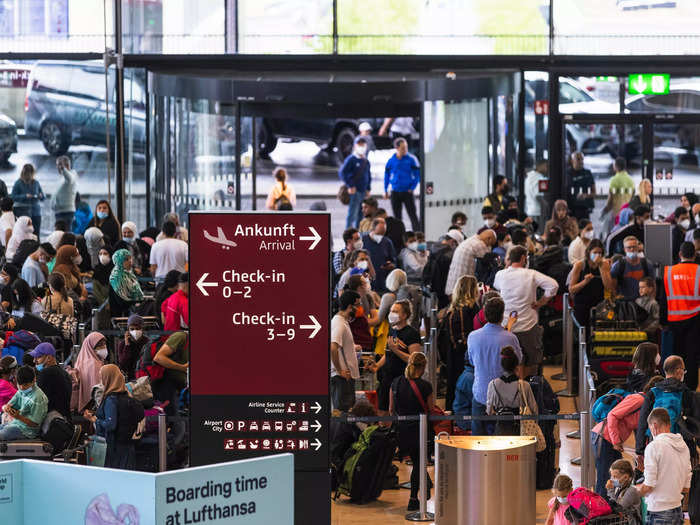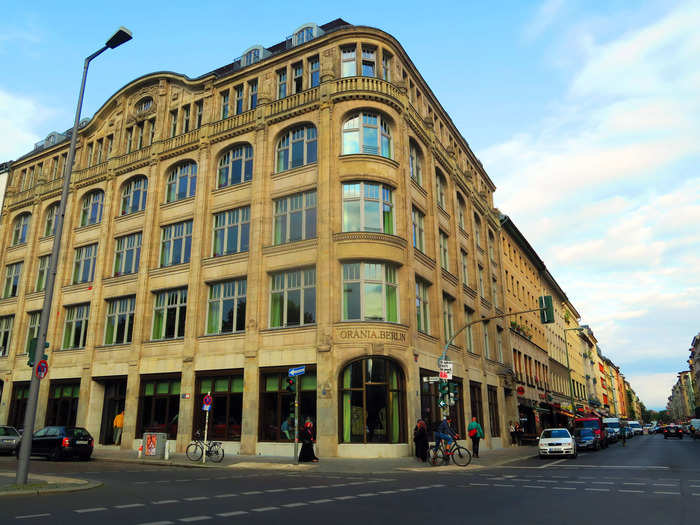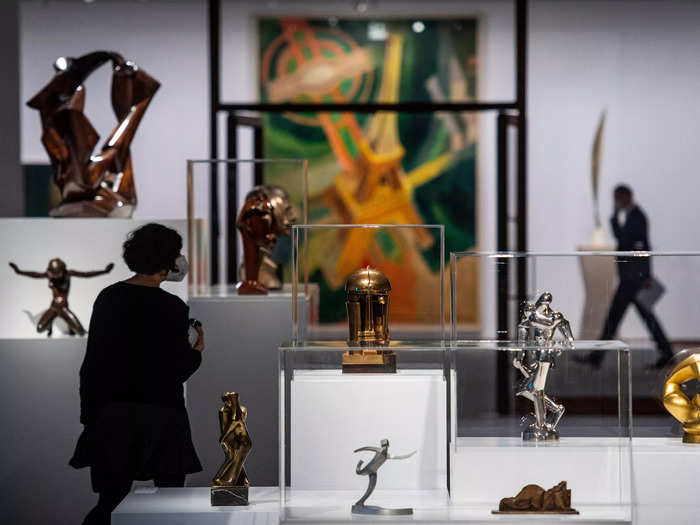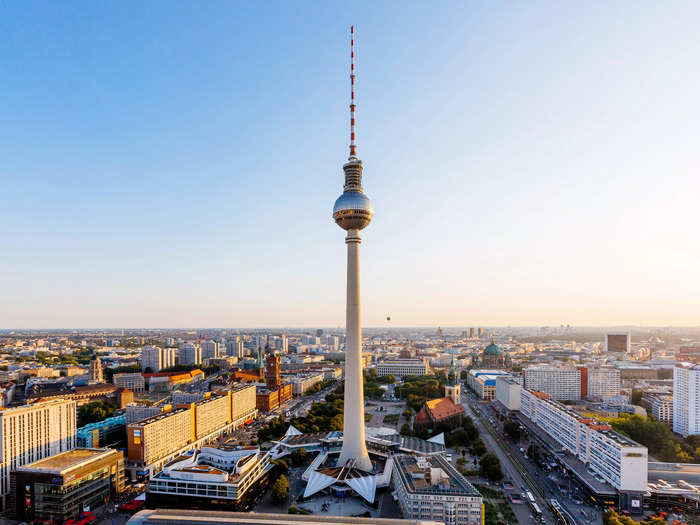Your ultimate guide to visiting Berlin
Jennifer Ceaser

- Sublime landmarks and cultural experiences await those who are planning a trip to Berlin.
- To simplify your planning, read Insider's comprehensive guide to visiting the city.
Since the fall of the Berlin Wall more than three decades ago, Germany's capital has emerged as one of the world's most captivating cities.
Where else can you cycle on a retired airport runway, see world-class art in a modernist icon, dine inside an antique pharmacy, and dance in an old power plant all in one day?
You could easily build your trip around Berlin's innumerable historical monuments and vast array of museums (over 175 at last count). But there's much more to the capital: great shopping, gorgeous parks, and a vibrant global restaurant scene to boot.
Check out Insider's guide to making the most of a trip to Berlin.
What to know when traveling to Berlin

As one of the most culturally significant cities in Germany, Berlin is a revered travel hot spot. If you've decided to pay a visit, there's some need-to-know information to keep in mind for the early stages of planning a seamless trip.
Find the best options for getting to and around Germany's capital, then read up on the country's entry requirements.
Berlin Brandenburg Airport
Berlin's only airport is the Berlin Brandenburg Airport (BER), located about 16 miles south of the city center in Schönefeld. More than 75 airlines operate out of Berlin Brandenburg Airport (view them all).
The airport is well connected to the city by Regional-Express (RE), Airport Express (FEX), and rapid-city (S-Bahn) trains, all operated by Deutsche Bahn, or DB. Find out more about public-transport options from the airport here. Taxis, Uber, and rental cars are also available.
Once you've arrived in Berlin and are ready to explore, you can get around easily using these options:
DB and BVG
DB's regional and S-Bahn trains together with BVG's underground U-Bahn, trams, and buses make up Berlin's extensive public-transport network.
Berlin has three zones — A, B, and C — with the majority of attractions located in the A zone. Within these zones, tickets purchased via BVG are valid for all forms of public transport. You can buy tickets from automated kiosks at any S-Bahn or U-Bahn station or on the BVG app. Visit the BVG website to plan your route.
App-based car services
Uber is widely available in Berlin. Another option is the more affordable ride-sharing app Berlkönig, but it is available only in German.
Taxis
You can hail a cab or book one via the Free Now app.
Berlin's COVID-19 travel policies
While Germany is open to travelers, the country has implemented strict border policies due to the COVID-19 pandemic. Visitors from the US may enter but will have to provide one of the following (for age 12 and over):
- Proof of vaccination with an approved vaccine listed by the Paul Ehrlich Institute, with full vaccination completed at least 14 days before the flight
- A negative test result 48 hours (for antigen tests) or 72 hours (for PCR tests) before boarding
- Proof of recovery from COVID-19, through a positive PCR test taken at least 28 days but no more than six months prior
The German government also requires all travelers (regardless of age) to complete a digital registration form. After filling out the necessary information, you will receive a PDF file by email that you must present before boarding your flight.
Entry requirements could change at any time, so be sure to check the Federal Ministry of Health website for updates.
Where to stay in Berlin

Berlin offers a plethora of hotel choices, including swanky five-stars, boutique gems, and budget-friendly stays. Best of all, room rates are far more affordable than other major European capitals, making even high-end properties within reach.
First timers should opt for hotels around Potsdamer Platz, Gendarmenmarkt, and Unter den Linden, which are convenient to prime tourist sites like the Brandenburg Gate and Museum Island.
For those seeking a more authentic, local Berlin experience, consider staying in an outlying kiez (neighborhood) like Kreuzberg. You can use sites like Booking.com and Trivago.com to choose a hotel or check into one of our favorites below.
Hotel de Rome
Occupying a magnificent 1880s neoclassical bank building on historic Bebelplatz, Hotel de Rome, from the luxury Rocco Forte chain, is worth the splurge. Marvelous original details — soaring stucco ceilings, white marble floors, gleaming oak paneling — blend with contemporary furnishings for an elegant, modern feel.
Join the fashionable crowd on the rooftop terrace for stellar cocktails and spectacular views of the neighboring Berlin Cathedral, the State Opera house, and the iconic TV Tower.
Hotel Zoo
West Berlin's Hotel Zoo has drawn stylish guests, including the likes of Sophia Loren, for over a century, thanks to its top-notch location on Kurfürstendamm, Berlin's boutique-lined shopping street.
Recently updated interiors fuse art deco glamour with eye-catching contemporary design, including whimsical touches like an elevator decked out with paparazzi-inspired flashing bulbs. Furnishings in plush velvet and leather grace the cozy rooms while apartment-sized suites come with a freestanding soaking tub and a full bar with a stocked wine fridge.
Orania Berlin
Nightlife aficionados will adore Orania Berlin, set among a sea of eclectic bars, restaurants, and clubs that define gritty, multicultural Kreuzberg. Step inside the restored art nouveau building and you're greeted by a windowed, open-plan lounge flanked by wood-burning fireplaces and anchored by a long wooden bar.
The rooms feature sophisticated spaces outfitted with warm wooden floors and furnishings, embroidered textiles, and comfortable beds handmade in Germany. During a night in, you can relax on a low-slung sofa with a cocktail and enjoy free nightly music played on the grand piano
Where to eat in Berlin

You don't need to look far to find classic German schnitzel or the humble, Berlin-born currywurst (sliced sausage smothered in a curried ketchup sauce). But the capital has gone global with a dining scene that is as diverse and creative as its residents. Restaurants are embracing what's fresh and local while bringing an international flair to the farm-to-table experience.
Here are some of the tastiest spots to try.
Coda
Deep in edgy Neukölln, the groundbreaking Coda has shaken up the concept of dessert, snagging two Michelin stars with its unconventional take on the typical final course.
Tasting menus feature seasonal confections with intriguing sweet and savory combinations like grilled figs with maple syrup, hazelnuts, and anchovies (trust us, it works). Each is perfectly paired with a custom-blended drink to enhance the dish's flavors.
Ora
At Kreuzberg's Ora the food is nearly upstaged by the glorious setting, inside a beautifully preserved 1860 pharmacy lined with original wood-and-glass apothecary shelves and antique medicine bottles.
Showcasing seasonal, sustainable ingredients, the daily two- to four-course menu is creative yet accessible, while the ambitious wine list offers some wonderful surprises.
Crackers
Finding the Mitte dinner spot Crackers is half the fun; we won't give away everything, but it involves an alley, a staircase, and a restaurant kitchen.
In the cavernous, black-walled dining room — once a famous nightclub — a trendy crowd nibbles on organic, Asian-inspired veggie dishes and locally sourced steaks as DJs spin cool tunes.
Briefmarken Weine
A Soviet-era postage stamp store on East Berlin's Karl-Marx-Allee is now the setting for Briefmarken Weine, which offers more than 200 biodynamic and natural wines from Italy on its menu.
There's always a nice selection of artisanal Italian cheeses and salumi, but save room for the daily pasta specials — all handmade and delicious. Reservations are essential.
What to do in Berlin

Berlin might be known for its unfettered nightlife, but it's also a city rich in culture and history. Home to over 175 museums — plus countless historical sites commemorating its complex past — the capital can easily keep sightseers busy for weeks on end.
But if you have only limited time, here are four can't-miss attractions to add to your itinerary.
Humboldt Forum
Nearly two decades in the making, the much-anticipated Humboldt Forum finally opened its doors in July 2020. A reconstructed baroque palace with boxy, modern elements, this cultural complex is massive, with 325,000 square feet of exhibition space spread over four floors, plus a roof terrace slated to open in the fall.
It's a hodgepodge of collections that's sure to pique your interest, from 17th-century sculpture to archaic computers to a state-of-the-art interactive exhibit that invites you to explore what it means to be a Berliner.
Neue Nationalgalerie
The newly reopened Neue Nationalgalerie looks much like the old one, and that's the point: Why mess with perfection? The legendary architect Ludwig Mies van der Rohe completed this glass and steel modernist edifice in 1968.
The refurbishment preserved and improved the building, carving out more gallery space to display the museum's sublime collection of 20th century art from such masters as Otto Dix, Pablo Picasso, and Andy Warhol.
Tempelhof Airport
The largest monument in Europe, Tempelhof Airport has a history that spans from its Nazi-era construction to the 1948-1949 Allied airlift during the Soviet blockade to its last commercial flight in 2008. Go inside through a tour, which highlights the most interesting architectural and historical aspects of the landmark. Most tours are given in German, but some are given in English on specific days at certain times.
You won't need a tour to visit the adjacent airfield, however, whose abandoned runways and vast meadows have been transformed into a popular urban park.
Disgusting Food Museum Berlin
You know you're in for something different when you're handed a sickness bag instead of an admission ticket. The Disgusting Food Museum Berlin showcases plenty of undeniably revolting products, including an Italian cheese crawling with maggots and a Swedish liqueur made with beavers' anal-gland secretions.
But it also has a serious side, providing cultural context to what's eaten in different parts of the world. You'll end your experience at the tasting bar, where you can sample several of the foods on view, which might include dehydrated mealworms, a German cheese made with mites, and even that stomach-turning Swedish liqueur.
Advisories for visiting Berlin

A trip to Berlin is a guaranteed adventure full of rich cultural experiences. But to fully enjoy what Germany's capital has to offer, it's important to figure out all the tactical aspects of your visit. Read up on Berlin's latest health and safety regulations, plus the need-to-know info that will help make your sojourn a success.
COVID-19 advisory
Berlin has instituted some fairly tough COVID-19 measures, requiring that masks be worn in all indoor public spaces. While on public transport, you must use N95 or FFP2 masks (not cloth masks).
Most bars and restaurants will not allow you to dine or drink inside unless you can provide proof of vaccination, recovery from COVID, or a negative test result. Hotels require the same qualifications for stays, as do nightclubs for entry.
The easiest way to show proof of any of the aforementioned is to download the Luca app, available in English, which stores your vaccination information and allows you to check into various venues using a QR code for contact tracing.
Weather advisory
Berlin isn't known for having great weather. It rains on average 140 days a year and frequently during the warmer summer months. Winters are long, with short days, gray skies, and frigid temperatures that hover around 33 degrees Fahrenheit. No matter what time of year you visit, pack a rainproof jacket and layers because even summer nights can be chilly.
Store hours
All stores, including supermarkets and most pharmacies, are closed on Sundays. The exceptions are corner stores, known as Spätkaufs, or more familiarly, Spätis. Plan ahead since only pharmacies can sell medicine and common painkillers.
Payment methods
Cash is king in Berlin. Many restaurants, bars, and shops won't accept credit or bank cards. That holds true even at pricey restaurants (though all hotels take cards). Keep a fair amount of cash on hand; ATMs, called Geldautomat, can be found all over the city.
READ MORE ARTICLES ON
Popular Right Now
Popular Keywords
Advertisement